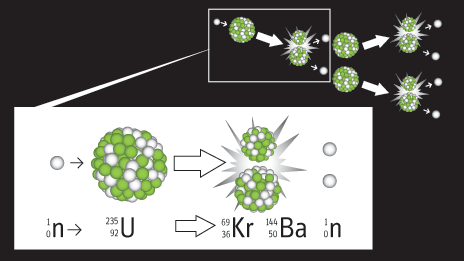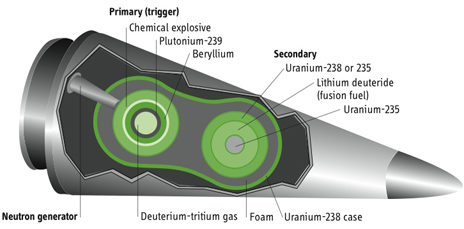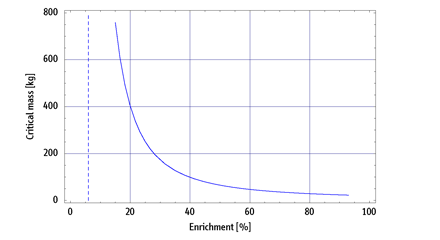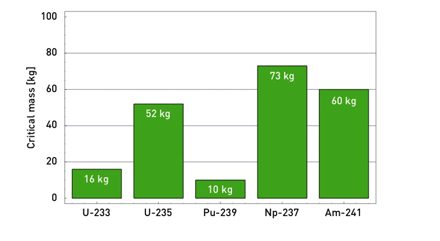Time Travel Research Center © 2005 Cetin BAL - GSM:+90 05366063183 - Turkey/Denizli
FISSILE MATERIALS & NUCLEAR WEAPONS
Fissile materials are materials that can sustain an explosive fission chain reaction. They are essential in all nuclear explosives, from first-generation fission weapons to advanced thermonuclear weapons. The most common fissile materials in use are uranium highly enriched in the isotope U-235, and plutonium. Lack of access to these materials is the main technical obstacle that can be put in the way of the acquisition of nuclear weapons.
Explosive Fission Chain Reaction
When the nucleus of a fissile atom -- say U-235 or
Pu-239 -- absorbs a neutron, it will, usually split into two smaller nuclei.
In addition to these fission products each fission releases two to three
neutrons that can cause a chain reaction in a "critical mass" of fissile
materials (Figure 1). Each fission of an atomic nucleus releases one hundred
million times the energy released per atom in a typical chemical reaction. A
large number of such fissions occurring over a short period of time in a
small volume results in an explosion. The fission of one kilogram of fissile
materials the approximate amount that fissioned in both the Hiroshima and
Nagasaki bombs releases an energy equivalent to the explosion of about 18
thousand tons (18 kilotons) of chemical high explosive.
The minimum amount of material needed for a chain reaction to be sustained
is defined as the critical mass of the fissile material. A "sub-critical"
mass will not sustain a chain reaction, because too large a fraction of the
neutrons escape from the surface before being absorbed by a fissile nucleus.

Fission Weapon Design
Nuclear weapons are either pure fission explosives,
such as the Hiroshima and Nagasaki bombs, or two-stage, thermonuclear
weapons.
The Hiroshima bomb contained about 60 kilograms of uranium enriched to about
80 percent in chain-reacting U-235. This was a "gun-type" device in which
one sub-critical piece of HEU was fired into another to make a super-critical
mass (see Figure 2, top). The Nagasaki bomb operated using implosion, which
has been incorporated into most modern weapons. Chemical explosives implode
a sub-critical mass of material to a higher density. This reduces the spaces
between the atomic nuclei and results in less leakage of neutrons out of the
mass, with the result that it becomes "super-critical" (see Figure 2, bottom).
For either design, the maximum yield is achieved when the chain reaction is
initiated at the moment the weapon assembly is most supercritical.
HEU can be used in either gun-type or implosion weapons. As is explained
below, plutonium cannot be used to achieve a high-yield explosion in a gun-type
device.

Gun-type weapons are simple devices and do not
require testing. They therefore could be built and stockpiled clandestinely
by a technically unsophisticated state. This is what South Africa did during
the Apartheid regime. Gun-type designs are also well within the reach of
subnational groups. The U.S. Department of Energy has warned that it may
even be possible for intruders in a fissile-materials storage facility to
use nuclear materials for onsite assembly of an improvised nuclear device in
the short time before guards could intervene.
In advanced implosion weapons, the yield is typically "boosted" by up to an
order of magnitude by introducing a mixed gas of deuterium and tritium,
heavy forms of hydrogen, into the hollow shell of the fissile materials or "pit"
of the weapon just before it is imploded. When the temperature of the
fissioning materials inside the pit reaches 100 million degrees, it can
ignite the fusion of tritium with deuterium, which produces a burst of
neutrons that "boost" the fraction of fissile materials fissioned and
thereby the power of the explosion.
In a thermonuclear weapon, a nuclear explosion of a fission "primary"
generates x-rays that compress and ignite a "secondary" containing
thermonuclear fuel, where much of the energy is created by the fusion of the
light nuclei, deuterium and tritium. The tritium is made during the
explosion by neutrons splitting lithium-6 into tritium and helium (see
Figure 3).
Modern nuclear weapons generally contain both plutonium and HEU. Both
materials can be present in the primary fission stage of a thermonuclear
weapon. HEU also is often used in the secondary stage of thermonuclear
weapon to provide the same yield in a more compact design.

Typical Quantities of Fissile Materials in Nuclear Weapons
The amount of material required to constitute a
critical mass can vary widely, depending on the fissile material, its
chemical form and the characteristics of the surrounding materials that 'reflect'
neutrons back into the core. Without neutron reflection, the bare critical
masses for Pu-239 and U-235 metal are about 10 kg and 52 kg respectively.
The actual amounts of fissile materials in the pits of modern implosion-type
nuclear weapons are considerably smaller.
The IAEA defines a "significant quantity" of fissile material to be the
amount required to make a first-generation implosion bomb of the Nagasaki-type
(see Figure 2), including production losses. The significant quantities are
8 kg for plutonium and 25 kg of U-235 contained in HEU.
The United States has declassified the fact that 4 kg of plutonium is
sufficient to make a nuclear explosive device. Based on the critical mass
ratios, about three times that amount (about 12 kg) of HEU would be
sufficient in a similarly designed fission weapon.
A rough estimate of average plutonium and HEU in deployed thermonuclear
weapons can be obtained by dividing the estimated total stock of weapons
fissile materials possessed by Russia and the United States at the end of
the Cold War by the sum of the maximum numbers of nuclear weapons that each
deployed during the Cold War: about 3 kg of plutonium and 25 kg of HEU.
Highly Enriched Uranium (HEU)
U-235, in nature, makes up only 0.7 percent of
natural uranium. The remainder is almost entirely non-chain-reacting U-238.
Although an infinite mass of uranium with U-235 enrichment of 6 percent
could, in principle, sustain an explosive chain reaction, uranium enriched
to above 20 percent U-235, defined as "highly enriched uranium", is
generally taken to be required for a weapon of practical size. The IAEA
therefore considers HEU a "direct use" weapon-material.
Actual weapons use higher enrichment, however, as reflected by the
definition of "weapon-grade" uranium as enriched to over 90-percent in
U-235. Figure 4 shows the critical mass of uranium as a function of
enrichment. To enrich uranium in U-235 requires sophisticated isotope
separation technology. Isotope separation on the scale required to produce
nuclear weapons is still within the reach of only government-sponsored
programs.

Plutonium
Plutonium is produced in a nuclear reactor when U-238 absorbs a neutron creating U-239, which subsequently decays to plutonium-239 (Pu-239) via the intermediate short-lived isotope neptunium-239. The longer an atom of Pu-239 stays in a reactor after it has been created, the greater the likelihood that it will absorb a second neutron and become Pu-240 -- or a third or fourth and become Pu-241 or Pu-242. Plutonium therefore comes in a variety of isotopic mixtures. Weapon designers prefer to work with a mixture that is as rich in Pu-239 as feasible because of its relatively low rate of generation of radioactive heat and relatively low spontaneous emissions of neutrons and gamma rays. Weapon-grade plutonium contains more than 90 percent of the isotope Pu-239. The plutonium in typical power-reactor spent fuel (reactor-grade plutonium) contains between 50 and 60 percent Pu-239, and about 25 percent Pu-240.
For a time, many in the nuclear industry believed
that the plutonium generated in power reactors could not be used for weapons.
It was believed that the large fraction of Pu-240 in "reactor-grade" Pu-240
would reduce the explosive yield of a weapon to insignificance. Pu-240
fissions spontaneously, emitting neutrons leading to a probability that
increases with the percentage of Pu-240 that the neutrons would initiate a
chain reaction before the bomb assembly reaches its maximum super-critical
state. For gun-type designs, such "pre-detonation" reduces the yield a
thousand-fold even for weapon-grade plutonium. The higher neutron production
rate from reactor-grade plutonium similarly reduces the probable yield of an
implosion design but only by ten-fold, because of the much shorter time
for the assembly of a supercritical mass. In the first-generation Nagasaki
design, even for the earliest possible pre-initiation of the chain reaction,
the yield would not be reduced below about 1000 tons TNT equivalent. That
would still be a devastating weapon.
More modern designs are insensitive to the isotopic mix in the plutonium. As
summarized in a 1997 U.S. Department of Energy report:
"[V]irtually any combination of plutonium isotope
... can be used to make a nuclear weapon. ... [R]eactor-grade plutonium is
weapons-usable, whether by unsophisticated proliferators or by advanced
nuclear weapon states ...
At the lowest level of sophistication, a potential proliferating state or
sub-national group using designs and technologies no more sophisticated than
those used in first-generation nuclear weapons could build a nuclear weapon
from reactor-grade plutonium that would have an assured, reliable yield of
one or a few kilotons (and a probable yield significantly higher than that).
At the other end of the spectrum, advanced nuclear weapon states such as the
United States and Russia, using modern designs, could produce weapons from
reactor-grade plutonium having reliable explosive yields, weight, and other
characteristics generally comparable to those of weapons made from weapon-grade
plutonium."
Other Fissile Materials
In addition to plutonium, other weapons-useable
fissile materials can be produced by irradiating different target materials
in nuclear reactors or by the decay of certain isotopes of plutonium. Among
these are uranium-233, neptunium-237, and americium-241. The bare critical
masses of these alternative fissile materials, along with those of Pu-239
and U-235, are shown in Figure 5.
While Pu-239 and U-235 are the dominant fissile materials used in the
weapons programs of all the nuclear-weapon states, the United States, at
least, has tested designs containing U-233. France, and perhaps other
nuclear weapon states, may have experimented with neptunium-237 in nuclear
tests.
We are unaware of any public report of weapons experiments involving
americium, but U.S. weapons designers have concluded that "designs using
americium as a nuclear weapon fuel could be made to work."

Hiçbir yazı/ resim izinsiz olarak kullanılamaz!! Telif hakları uyarınca bu bir suçtur..! Tüm hakları Çetin BAL' a aittir. Kaynak gösterilmek şartıyla siteden alıntı yapılabilir.
The Time Machine Project © 2005 Cetin BAL - GSM:+90 05366063183 -Turkiye/Denizli
Ana Sayfa /
index /Roket bilimi /![]() E-Mail /CetinBAL/Quantum Teleportation-2
E-Mail /CetinBAL/Quantum Teleportation-2
Time Travel Technology /Ziyaretçi Defteri /UFO Technology/Duyuru